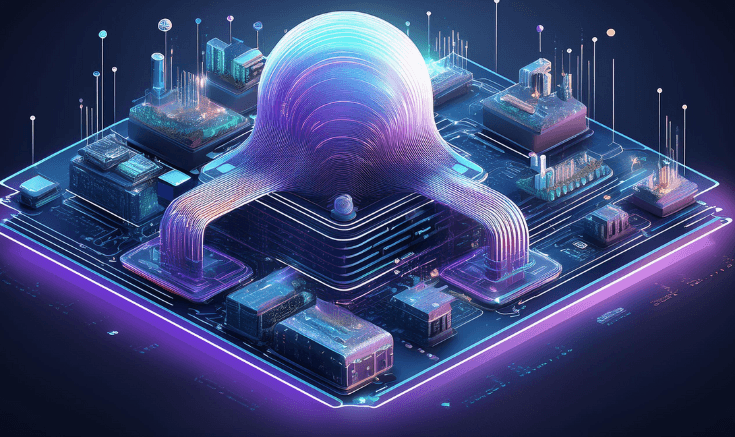

Developing AI models in 2025
FEB. 24, 2025
5 Min Read
AI model development is reshaping industries by improving automation, analytics, and efficiency.
Organizations that build AI solutions tailored to their specific needs gain measurable advantages in speed, accuracy, and cost savings. The ability to process large datasets, generate predictions, and automate workflows makes AI a valuable asset for businesses looking to optimize operations and scale their solutions. Developing an AI model requires a structured approach that includes defining objectives, selecting the right algorithms, training with high-quality data, and deploying models that integrate seamlessly with existing infrastructure. Generative AI models expand these capabilities by creating content, improving user interactions, and allowing automation at a previously unattainable level. As AI adoption increases, companies must focus on building models that are scalable, efficient, and aligned with long-term business goals.
Key Takeaways
- 1. AI models improve automation, efficiency, and scalability, making them valuable for industries looking to optimize workflows and reduce costs.
- 2. Supervised, unsupervised, reinforcement, and generative AI models serve different functions, allowing businesses to choose the best fit based on their objectives.
- 3. High-quality data collection and preprocessing play a critical role in training AI models that produce accurate and reliable outputs.
- 4. Generative AI expands automation by producing text, images, and audio, improving content creation and user interactions across multiple industries.
- 5. Scalable AI models require ongoing evaluation, monitoring, and refinement to maintain accuracy and adapt to varying data patterns.
What are AI models?

AI models are computational systems that process data, recognize patterns, and make predictions. These models are essential for automating tasks, optimizing processes, and enhancing analytics in healthcare, finance, logistics, and manufacturing industries. From fraud detection to predictive maintenance, AI models improve accuracy and efficiency while reducing costs. Organizations that invest in AI solutions focus on scalability, adaptability, and measurable business impact.
Each model uses algorithms that analyze vast datasets to generate insights and automate decisions. Some models specialize in identifying patterns in structured data, while others excel at interpreting text, images, or audio. The effectiveness of an AI model depends on data quality, computational power, and how well it aligns with business goals. Selecting the right model ensures better performance, faster processing, and a greater return on investment.
Models vary in complexity, from simple decision trees to deep learning architectures capable of processing large volumes of unstructured data. Understanding these models allows organizations to make informed choices about AI adoption, helping them streamline operations and improve business outcomes. The next step in AI development is identifying which model best fits the use case, computational needs, and long-term objectives.
Types of AI models
AI models are designed to solve distinct challenges based on how they process and interpret data. Some models specialize in classification, prediction, or anomaly detection, while others focus on generating new content or learning through reinforcement. The effectiveness of an AI model depends on its ability to process data efficiently, adapt to different use cases, and scale according to business needs. Selecting the right model impacts operational efficiency, resource allocation, and the overall value an AI system delivers. Each model type serves a specific purpose, with strengths aligning with the finance, healthcare, manufacturing, and logistics industries. Choosing the best fit requires assessing dataset availability, computational requirements, and accuracy expectations.
"Selecting the right AI model impacts performance, scalability, and cost-effectiveness. The best approach depends on business priorities, data availability, and infrastructure capabilities."
- Supervised learning models: These models rely on labeled datasets to train algorithms for classification and regression tasks. They excel in fraud detection, medical diagnostics, and predictive maintenance applications. Decision trees, support vector machines, and neural networks belong to this category.
- Unsupervised learning models: These models analyze unlabeled data to identify patterns, clusters, and anomalies. They are frequently used in customer segmentation, market analysis, and cybersecurity threat detection. Standard techniques include k-means clustering and principal component analysis.
- Reinforcement learning models: These models operate based on feedback from interactions, refining their actions over time to maximize rewards. They play a key role in robotics, autonomous systems, and advanced gaming strategies. Applications such as automated trading platforms and self-learning recommendation engines rely on this approach.
- Deep learning models: These models process large volumes of complex data through multi-layered neural networks. They are widely used in image recognition, speech processing, and natural language understanding. Convolutional neural networks (CNNs) support visual data analysis, while recurrent neural networks (RNNs) handle sequential inputs like speech and time series forecasting.
- Generative models: These models create new data by learning patterns from existing datasets. They power applications such as AI-generated text, synthetic image creation, and deepfake technology. Generative adversarial networks (GANs) and transformer-based models are common in this category.
- Hybrid AI models: These models combine multiple AI techniques to enhance efficiency, adaptability, and accuracy. A system that integrates supervised learning with reinforcement learning can improve supply chain forecasting or personalized healthcare recommendations.

The right AI model accelerates time to value and optimizes outcomes based on business goals. Organizations that align AI capabilities with operational priorities gain better accuracy, scalability, and cost-efficiency. As AI adoption expands, selecting models that integrate seamlessly with existing processes and infrastructure provides a competitive edge in industries seeking measurable impact.
Best practices on how to develop AI models
AI model development requires a structured approach that prioritizes accuracy, efficiency, and adaptability. The success of an AI model depends on how well it is trained, tested, and deployed within a system. Models that are designed with clear objectives, high-quality data, and robust evaluation criteria perform better and integrate more effectively into business operations. A well-planned development process reduces costs, accelerates implementation, and improves the reliability of AI-based solutions.
Each stage of development plays a role in refining the model’s capabilities. From identifying the problem to monitoring performance after deployment, careful planning helps avoid inefficiencies and improves long-term accuracy. Following best practices ensures that AI models align with industry requirements, regulatory compliance, and operational needs.
Identifying the problem
AI models are built to solve specific problems, making problem definition one of the most critical steps in development. A well-defined problem statement sets clear objectives and aligns model capabilities with expected outcomes. AI applications span across industries, from predictive analytics in healthcare to automation in logistics and financial risk assessment.
Establishing measurable performance indicators improves the ability to assess model success. A clear scope prevents overcomplication, making fine-tuning the model during development easier. Without a defined purpose, AI models risk generating outputs that do not translate into actionable insights.
Collecting data
An AI model's accuracy depends on the quality and quantity of the data used during training. Data must be representative of the problem the model is intended to address. Depending on the AI application, sources may include transactional records, sensor outputs, textual data, and multimedia content.
Diverse datasets improve model generalization, reducing bias and preventing skewed predictions. Gaps in data collection can lead to errors, making it necessary to assess whether additional sources are required. Expanding the dataset through augmentation techniques helps strengthen model performance in cases where data is limited.
Preparing data for AI
Raw data contains inconsistencies that must be addressed before model training begins. Cleaning, organizing, and formatting data improves accuracy and prevents unnecessary computational complexity. Common preprocessing steps include handling missing values, normalizing numerical data, and encoding categorical variables.
Feature selection plays a key role in refining the dataset. Identifying high-impact attributes reduces noise and improves training efficiency. Organizing data into training, validation, and testing subsets allows for better performance assessment before deployment.
Choosing the right framework
AI frameworks provide essential tools for building, training, and deploying models. Selecting a framework depends on model complexity, computational requirements, and compatibility with existing infrastructure. Open-source libraries such as TensorFlow, PyTorch, and Scikit-learn offer different advantages based on the intended AI application.
Some frameworks are optimized for deep learning, while others support traditional machine learning techniques. Cloud-based AI services provide flexible computing power, eliminating the need for on-premise infrastructure in cases where scalability is a priority. Choosing the right framework impacts development speed and the model’s ability to process data efficiently.
Training the AI model
Training involves feeding the model with data and optimizing parameters to improve accuracy. The learning process adjusts weights and biases over multiple iterations to minimize errors. The choice of optimization algorithms influences how well the model generalizes to new data.
Techniques such as cross-validation, batch normalization, and regularization prevent overfitting. Large-scale deep learning models often require GPUs or TPUs to accelerate training. Fine-tuning hyperparameters and adjusting model architecture improves performance while balancing computational costs.
Evaluating the model's performance
After training, the model must be tested to verify its reliability and accuracy. Performance metrics such as precision, recall, and F1 score assess how well the model aligns with its intended purpose. Evaluating against real data helps determine whether the model performs consistently in different conditions.
Testing across various data inputs ensures the model does not rely too heavily on patterns in the training dataset. Stress testing with edge cases identifies weaknesses that may cause inaccuracies. Models not meeting performance benchmarks require further refinement, additional training data, or structural adjustments.
Deploying the AI model
Deployment integrates the trained model into operational systems where it can generate predictions. The deployment method depends on processing requirements, security policies, and scalability needs. Depending on infrastructure constraints, cloud-based, edge, or on-premise solutions may be used.
Ongoing monitoring detects performance degradation, prompting retraining when necessary. AI models must adapt to shifts in data patterns over time to maintain accuracy. Regular updates and maintenance cycles extend the model’s usefulness and align it with business objectives.
Building an AI model that is efficient, scalable, and adaptable improves its impact on business operations. A structured development approach reduces deployment challenges and maximizes accuracy. Organizations that prioritize data quality, performance assessment, and infrastructure alignment gain higher returns from AI investments.
What are generative AI models?
Generative AI models create original content based on patterns learned from existing data. These models generate text, images, audio, and even video, making them essential for automation, content production, and interactive applications. Unlike traditional AI models focusing on classification or prediction, generative models produce new outputs tailored to specific use cases. Industries such as media, entertainment, and software development use these models to enhance efficiency, reduce costs, and improve scalability.
The ability to generate human-like responses, realistic imagery, and adaptive content comes from advanced neural network architectures. GANs refine content creation through a dual-network system where a generator produces new data while a discriminator evaluates its accuracy. Transformer-based models process vast amounts of text data, allowing AI to generate articles, translate languages, and write code with contextually relevant precision. These advancements have made generative AI models critical in content automation, digital interaction, and synthetic media creation.
Organizations adopting generative AI models focus on balancing creativity with control to achieve accurate and high-quality results. The ability to scale content production, personalize user interactions, and automate repetitive tasks makes these models valuable for companies looking to increase efficiency. The expansion of generative AI has redefined how businesses approach content generation, offering measurable improvements in workflow automation and creative output.
"Generative AI models create original content by learning patterns from existing data, expanding automation possibilities in text, image, and audio generation."
Use cases of generative AI models

Generative AI models significantly automate content creation, enhance productivity, and improve user experiences across multiple industries. These models create text, images, audio, and video with minimal human intervention, allowing businesses to scale operations, reduce costs, and introduce new efficiencies. The ability to generate high-quality outputs that align with specific requirements makes generative AI valuable for applications ranging from customer engagement to software development.
- Automated content generation: AI-powered models create marketing copy, reports, and summaries, reducing the time required for manual content production. Businesses use these models to generate blog posts, email campaigns, and product descriptions at scale while maintaining consistency and relevance.
- Conversational AI and virtual assistants: Chatbots and AI-powered assistants handle customer inquiries, provide recommendations, and automate responses in multiple languages. These models improve user engagement by generating context-aware replies that adapt to customer needs in real time.
- Synthetic image and video creation: AI-generated images and videos enhance design workflows, support advertising campaigns, and create virtual product prototypes. Fashion, gaming, and entertainment industries use these models to produce realistic visuals without requiring traditional production methods.
- Personalized recommendations: AI models analyze user preferences and generate tailored suggestions for media, e-commerce, and educational platforms. These systems create dynamic recommendations for music, movies, products, and learning materials based on individual behavior.
- Software code generation: Developers use AI models to generate, optimize, and debug code, improving efficiency in software development. These models help automate repetitive coding tasks, assist with documentation, and suggest real-time improvements.
- Music and speech synthesis: AI-generated music and voice cloning technology support applications in entertainment, accessibility, and content production. These models create realistic voices for audiobooks, virtual assistants, and digital media projects.
- Drug discovery and scientific research: AI generates molecular structures, predicts protein folding patterns, and accelerates drug formulation processes—the pharmaceutical industry benefits from AI-powered simulations that reduce development timelines and improve research accuracy.
Generative AI models improve efficiency by automating complex processes and reducing the effort required for manual tasks. These models provide businesses a cost-effective way to create personalized content, enhance user experiences, and optimize production workflows. The ability to scale these solutions while maintaining accuracy makes generative AI an essential tool for industries seeking measurable improvements in automation and innovation.
How to develop generative AI models

Developing a generative AI model requires a structured approach that prioritizes accuracy, efficiency, and adaptability. These models must be trained on high-quality data, optimized for specific use cases, and continuously refined to maintain reliability. The development process involves selecting the right architecture, preparing data, training the model, and evaluating performance before deployment. Organizations investing in generative AI focus on scalability, cost-effectiveness, and measurable improvements in automation.
Defining the use case
A generative AI model must be designed with a clear objective. Whether the goal is text generation, image synthesis, or voice replication, defining the use case helps align model architecture and data selection. The requirements for a chatbot differ from those of an AI-generated art tool or a music composition model. Identifying the intended application ensures the model produces outputs meeting business goals and user expectations.
Use cases in marketing, software development, and healthcare have distinct data needs and accuracy benchmarks. Once deployed, establishing key performance indicators (KPIs) helps measure the model’s effectiveness. Without a well-defined objective, AI models risk generating content that lacks precision or relevance.
Collecting and preprocessing data
Training a generative AI model requires a dataset that reflects the intended output. High-quality data improves the accuracy and reliability of generated content. Depending on the application, sources may include text corpora, image libraries, speech recordings, or structured numerical data.
Preprocessing ensures that the data is clean, balanced, and free from inconsistencies. Text tokenization, image normalization, and audio segmentation prepare datasets for AI training. Removing biases, duplicates, and irrelevant information reduces the likelihood of generating misleading or low-quality outputs. Data augmentation techniques help expand limited datasets, improving the model’s generalization ability.
Choosing the right architecture
Generative AI models rely on specialized architectures to produce high-quality content. The choice of architecture depends on the complexity of the task and the computational resources available. Some models specialize in text generation, while others excel in visual or audio synthesis.
- Generative adversarial networks: These models use a generator-discriminator framework to produce high-resolution images, videos, and synthetic media. Applications include AI-generated artwork, deepfake technology, and realistic virtual environments.
- Variational autoencoders (VAEs): These models learn efficient data representations to generate new samples resembling the original dataset. VAEs support applications in image synthesis, anomaly detection, and data augmentation.
- Transformer-based models: These models process large text datasets to generate coherent and contextually relevant responses. Language models such as GPT (Generative Pretrained Transformer) and BERT (Bidirectional Encoder Representations from Transformers) power conversational AI, automated writing tools, and translation systems.
Selecting the right model architecture impacts training efficiency, content quality, and adaptability across different use cases.
Training the generative AI model
Training a generative AI model involves feeding it with structured data and optimizing its parameters to produce meaningful outputs. The model learns patterns, structures, and relationships within the dataset through iterative refinement. The choice of training algorithms and hyperparameters affects how well the model generalizes to new inputs.
Techniques such as adversarial training, self-supervised learning, and reinforcement feedback loops improve model accuracy. Training deep learning models requires high-performance hardware, such as GPUs or TPUs, to handle large-scale computations efficiently. Fine-tuning pre-trained models reduces training time and enhances accuracy when working with limited data.
Evaluating model performance
After training, the model must be tested to verify its accuracy, coherence, and reliability. Evaluation metrics differ depending on the application, but key factors include fluency in text generation, realism in image synthesis, and naturalness in speech outputs.
Common evaluation methods include:
- Perplexity scores: Assess text model fluency by measuring how well a model predicts the next word in a sequence.
- Fréchet inception distance (FID): Measures the similarity between generated and real images to determine realism.
- Mean opinion score (MOS): Evaluates the quality of AI-generated speech or music based on human perception.
Testing the model against real scenarios ensures it performs consistently across different inputs. Bias detection, error analysis, and human evaluation further refine the output quality.
Deploying and monitoring the model
Once trained and evaluated, the model is integrated into applications that generate outputs in real time or batch-processing modes. Deployment strategies vary depending on infrastructure constraints, user interaction requirements, and computational needs.
Models can be deployed on cloud-based systems, edge devices, or embedded within applications for seamless operation. Ongoing monitoring detects performance shifts and adjusts the model as data patterns change. Regular updates, fine-tuning, and retraining cycles maintain accuracy and improve long-term effectiveness.
A robust generative AI model balances creativity, efficiency, and scalability. Organizations focusing on high-quality data, strong evaluation frameworks, and adaptive deployment methods gain better results from AI-powered content generation. The ability to automate workflows, personalize user interactions, and improve production efficiency makes generative AI a valuable investment in modern digital solutions.
Emerging trends in AI model development

AI models are becoming more efficient, requiring fewer computational resources while maintaining high accuracy. The shift toward smaller, optimized models allows faster processing, reduced energy consumption, and easier deployment across different platforms. Edge AI is expanding, allowing models to run on local devices instead of relying on cloud computing. This improves response times, enhances security, and lowers infrastructure costs. Multimodal AI, which integrates text, image, and audio generation, is also advancing, opening new possibilities for content automation, virtual assistants, and AI-powered analytics.
Transparency and ethical considerations are shaping how AI models are developed and deployed. Explainable AI (XAI) provides insights into how predictions are made, improving trust in automated systems. More organizations are adopting governance frameworks to align AI applications with regulatory requirements and reduce bias in training datasets. Research in low-resource AI makes technology more accessible, allowing businesses to implement AI solutions without requiring extensive infrastructure. The combination of efficiency, interpretability, and accessibility continues to shape the future of AI model development, making it more scalable and adaptable to real applications.
AI redefines how businesses automate processes, generate insights, and scale operations efficiently. Purpose-built AI solutions improve accuracy, reduce costs, and accelerate time to value by integrating seamlessly into existing workflows. At Lumenalta, we specialize in developing AI models that align with your strategic objectives, ensuring that your technology investments deliver measurable impact. Let’s build AI solutions that drive results.
Table of contents
- What are AI models?
- Types of AI models
- Best practices on how to develop AI models
- Identifying the problem
- Collecting data
- Preparing data for AI
- Choosing the right framework
- Training the AI model
- Evaluating the model's performance
- Deploying the AI model
- What are generative AI models?
- Use cases of generative AI models
- How to develop generative AI models
- Emerging trends in AI model development
- Common questions about AI models
Common questions about AI models
How to develop AI models that are scalable and cost-effective?
What are the best AI models for automation?
How does generative AI improve content creation?
What industries benefit most from AI model development?
How do AI models improve business efficiency?
Want to learn how AI can bring more transparency and trust to your operations?





